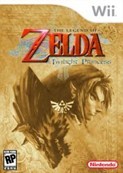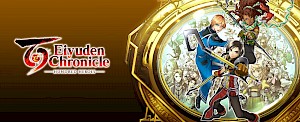Review: Zelda: Twilight Princess
Posted 25 Dec 2006 at 23:07 by Conor Smyth
Wii Review

| "Zelda lives or dies by the quality of dungeon design: here it positively soars. Every inch is calculated; nothing is wasted." |
'But is it better than Ocarina?' The spectre of Ocarina of Time hangs heavy over Twilight Princess. Like a ghost of gaming past, it has haunted every comment about the game since the its inception: every expectation, and every swing of Link's sword, every flush of the camera. Twilight Princess is a game soaked in its heritage, and the game walks a fine line between the old and the new. Occasionally it trips, or stumbles, but the game's success is in its triumphant traversing of the tightrope, and its brash confidence in its own abilities.
For the leagues of gamers like myself who came of age with Ocarina, playing Twilight Princess feels like a return home. After the diversions and subversions of Majora's Mask and The Wind Waker, Twilight Princess returns us to a familiar formula. It's the quintessential Zelda plot: a princess, a castle, a big bad, distressed kids, and worlds under siege. The laws of the classical epic are followed, almost as if the game is straining to demonstrate just how much of a Zelda game it really is. It threatens to become overbearing, even artificial, at times, but for the most part it works, and is the bold, stirring adventure the title promises us.
The game wants to be the biggest and the best Zelda to date, and to do so it borrows the trappings of the classic modern Zelda title, and runs with them. Its history is worn on its sleeve, unashamedly: we return to Hyrule, and all the Gorons and Zoras we met eight years ago. Indeed, the odd throwback is so obvious it beggars belief, and conjures pictures of Japanese designers busy with stencilling and tracing. On the way it picks up some baggage too - Wind Waker's colourful bursts of defeated enemies for example. This heavy reliance on the familiar is a double edged sword. It's obvious that if you're going to imitate, imitate the best. The Zelda franchise has always been impeccable in construction, but Ocarina has etched itself in contemporary gaming's consciousness in a way few games have achieved. To evoke it is to evoke the highest gaming standard, and the greatest of navigators is needed at the helm.
That's not to say there's nothing new in Twilight Princess: it's out on the Gamecube too (and it would be interesting to compare the two soon), but this version is for the Wii, and it doesn't ignore its motion sensitivity. Swing your sword, aim your bow. Many writers have noted the game's status as a Gamecube game with Wii parts bolted on – and that it is – but the final product gives little indication of this artificiality. The swordplay isn't truly motion sensitive - and this may or may not be vindicated – but the somewhat arbitrary replacement of buttons with specific movements does work oddly well. After a small period of adjustment, the Wii controls, rather than hinder the experience, actually improve it. Movement and combat is comfortably tactile, and the accuracy is something of a revelation. The mouse-like instinct of aiming a bow or a boomerang makes joysticks feel antiquated. It's a delicious refinement. Parts of the game diverge from normality too, when you transform into a wolf – a thing that could have been tacky, but complements the title's puzzle sensibilities. New items, combat moves and weapons present new opportunities for puzzles and combat, fleshing out the game admirably.
There is refinement in the presentation too. The Wii's relatively inferior innards mean flat textures and lazy definitions, but Nintendo work against this deficit, by pouring energy into the art style. The models don't inspire astonishment, but the technique often does. The game mostly operates with a naturalistic tone, but has a habit of draping it in colours and lighting that dazzle the sockets. When the sun hits its glory Hyrule shimmers in rich yellows and oranges: in the tinted twilight sections the environments adopt a hellish, putrid mix of blues and purples. When you step out of your humble village, and see the grass and barks of the wood are bathed in pure light, it's like walking through a painting. The Tron-like blacks and turquoises of the Twilight portals' hard contours jarring with the soft greens of Hyrule. Twilight Princess rarely loses sight of the dramatic in the visual.
Where the game really succeeds though, is in what's not new. It's the impeccable sense of design that makes Zelda captivating: the series has always worked because of the balance between captivating dramatic fantasy and tight, smart design. The latter of which comes through in spades, in some of the best dungeons we've seen. Zelda lives or dies by the quality of dungeon design: here it positively soars. Every inch is calculated; nothing is wasted. Every oddity, every placement has its reason. One of the joys of the game is that first encounter with a new dungeon room, and immediately scanning every inch to work out the way forward. A sometimes ruthless demand for lateral thinking forces you to sheath your blade and engage mentally with the dynamics around you. It's Conan Doyle with fairies. The invisible forces of progression and movement are so material you can almost feel the wisp through your fingers: working through the dungeons becomes a silent game between the player and the designers, as you feel out your expected movements and anticipate where the game is travelling. Occasionally you will stall in frustration, but for the most part, they are exercises in peerless design, and are the foundations of the game's excellence. The euphoric satisfaction when you grasp the solution, and the game sounds that iconic jingle in congratulations, is reason enough to love the game.
As mentioned, what Zelda does best is combine the grand and the small, and Twilight Princess has the grand. Even after all this time, the series still has the ability to wow the player, with real heart in your mouth moments. You will fight a dragon in the clouds, with the rain pelting and the lightning crashing and violins screeching like they are dying bloody deaths. You will duel on horseback with an ogre on a lonely bridge, suspended high in the air above water. Twilight's sense of scale and place is awesome, in the proper sense of the word. It's a world land of barren desserts basking in the moonlight, illuminated only by sparse torches, of far away horizons that stretch out from the highest point. It's a big world, and it's a big adventure. Wii Sports is the emperor of half-hour sessions at parties, but Zelda is a game hesitant to really change, demanding you slog it out for thirty, forty or fifty hours to reach the credits, and even then leaving you with hearts, poes and the other expected collectibles to search for.
That's the crux of the matter really. For all its improvements, refinements and additions, at its heart Twilight Princess is a game we fell in love with eight years ago. For all its spotless dungeons and dramatic sequences, the familiarity of Princess remains overpowering. The anachronisms - the archaic dungeon save system, the hesitancy to signpost progression properly - do jar. It is a game constructed by master designers and grand storytellers, and genuinely the most impressive Nintendo title in years. So is it better than Ocarina? It's a silly question, and hardly matters: it cannot have the same effect as Ocarina, because Ocarina was a product of its time, and a game that exudes an eternal shimmer for those of us who got our hearts thieved in the winter of ninety eight. But for a new league of gamers stepping blinking into the sun, this could be their Ocarina, and they could argue in another eight years, debating 'But is it better than Twilight Princess?' It's difficult to think of any higher compliment.
N-Europe Final Verdict
Engaging and rarely disappointing. A fine demonstration of the genre and the medium, and will leave the masses breathless.
- Gameplay5
- Playability5
- Visuals5
- Audio4
- Lifespan5
Final Score
10
Pros
It revisits and refines a modern classic.
Cons
It revisits and refines an eight year old game.

























